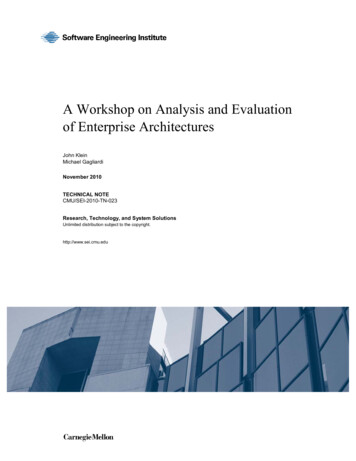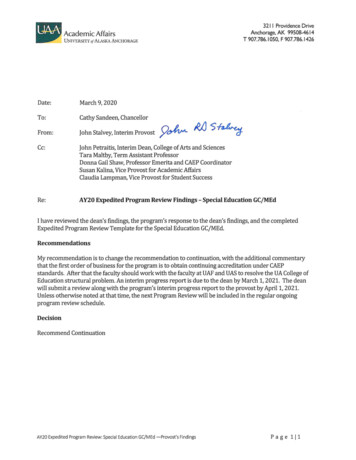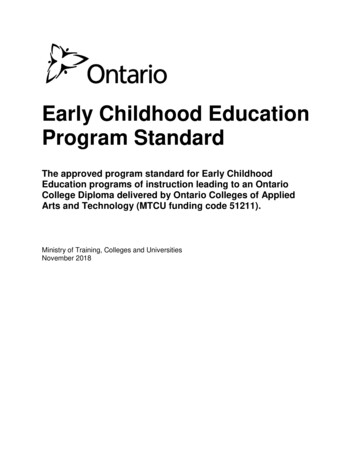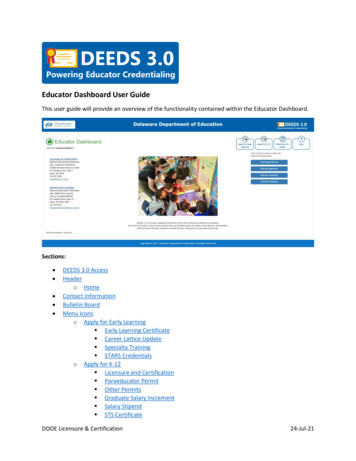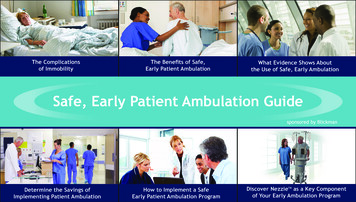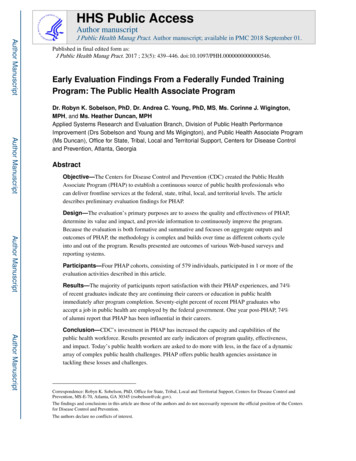
Transcription
HHS Public AccessAuthor manuscriptAuthor ManuscriptJ Public Health Manag Pract. Author manuscript; available in PMC 2018 September 01.Published in final edited form as:J Public Health Manag Pract. 2017 ; 23(5): 439–446. doi:10.1097/PHH.0000000000000546.Early Evaluation Findings From a Federally Funded TrainingProgram: The Public Health Associate ProgramAuthor ManuscriptDr. Robyn K. Sobelson, PhD, Dr. Andrea C. Young, PhD, MS, Ms. Corinne J. Wigington,MPH, and Ms. Heather Duncan, MPHApplied Systems Research and Evaluation Branch, Division of Public Health PerformanceImprovement (Drs Sobelson and Young and Ms Wigington), and Public Health Associate Program(Ms Duncan), Office for State, Tribal, Local and Territorial Support, Centers for Disease Controland Prevention, Atlanta, GeorgiaAbstractObjective—The Centers for Disease Control and Prevention (CDC) created the Public HealthAssociate Program (PHAP) to establish a continuous source of public health professionals whocan deliver frontline services at the federal, state, tribal, local, and territorial levels. The articledescribes preliminary evaluation findings for PHAP.Author ManuscriptDesign—The evaluation’s primary purposes are to assess the quality and effectiveness of PHAP,determine its value and impact, and provide information to continuously improve the program.Because the evaluation is both formative and summative and focuses on aggregate outputs andoutcomes of PHAP, the methodology is complex and builds over time as different cohorts cycleinto and out of the program. Results presented are outcomes of various Web-based surveys andreporting systems.Participants—Four PHAP cohorts, consisting of 579 individuals, participated in 1 or more of theevaluation activities described in this article.Results—The majority of participants report satisfaction with their PHAP experiences, and 74%of recent graduates indicate they are continuing their careers or education in public healthimmediately after program completion. Seventy-eight percent of recent PHAP graduates whoaccept a job in public health are employed by the federal government. One year post-PHAP, 74%of alumni report that PHAP has been influential in their careers.Author ManuscriptConclusion—CDC’s investment in PHAP has increased the capacity and capabilities of thepublic health workforce. Results presented are early indicators of program quality, effectiveness,and impact. Today’s public health workers are asked to do more with less, in the face of a dynamicarray of complex public health challenges. PHAP offers public health agencies assistance intackling these losses and challenges.Correspondence: Robyn K. Sobelson, PhD, Office for State, Tribal, Local and Territorial Support, Centers for Disease Control andPrevention, MS-E-70, Atlanta, GA 30345 (rsobelson@cdc.gov).The findings and conclusions in this article are those of the authors and do not necessarily represent the official position of the Centersfor Disease Control and Prevention.The authors declare no conflicts of interest.
Sobelson et al.Page 2Author ManuscriptKeywordsprogram evaluation; public health; training evaluation; workforce developmentAuthor ManuscriptA recent increase in the number of published articles describing the public health work-forcehas highlighted the need to develop and build the capacity and capability of the public healthworkforce.1–3 One strategy agencies use to ensure a workforce capable of meeting futurepublic health needs is to recruit and develop the next generation of public health workers andleaders through on-the-job, service-learning4–7 programs and fellowships. These types oftraining programs embrace the principles of adult learning theory, providing trainees withhands-on learning experiences, instructional support, and mentoring while on assignment topublic sector agencies and nonprofit organizations. For public health, service learningprograms and fellowships hold the promise of increased system capacity and a pipeline ofcapable workers for the future.Author ManuscriptEvaluation of these types of public health training programs is necessary to determine wherethey deliver on the promise and where they fall short; evaluation also guides programimprovement efforts. Today’s focus on greater accountability, transparency,8 and evidencethat demonstrates “what works” reinforces the importance of evaluation in planning andimplementing public health workforce training programs.9 However, evaluation efforts canbe cumbersome and costly for an agency10; they can often take years to plan, implement,and deliver results. Evaluating training programs can be particularly challenging, as there areunique methodological issues associated with measuring training outcomes and results.11–13These issues include the distal nature of training outcomes, the number of confoundingvariables influencing the benefit and utility of training within an organization, and the lackof funding for, and experience in, training evaluation.11–13 As a result, many programschoose to employ basic monitoring techniques during the program14 and sometimesimplement a more rigorous evaluation at the program’s end. However, in times of decreasedfederal budgets and increased scrutiny of use of federal funds, there is a need to provideevidence of program’s quality, effectiveness, and impact while the program is in progress.The purpose of this article is to describe evaluation findings for the Public Health AssociateProgram (PHAP), a 2-year service learning program for early-career professionals.Program OverviewAuthor ManuscriptThe Centers for Disease Control and Prevention (CDC) created PHAP (originally named thePublic Health Apprentice Program) in 2007 as a pilot program. The goal was to establish acontinuous source of public health professionals who could deliver front-line services at thefederal, state, tribal, local, and territorial levels.15 PHAP seeks to improve the capacity andcapability of the public health workforce through recruitment, placement, and training ofearly-career professionals.Once accepted into the program, participants, referred to as “associates,” work as CDCemployees. Associates complete assignments in health departments or nonprofitorganizations across the country, referred to as “host sites.”15 Since 2007, a total of 278J Public Health Manag Pract. Author manuscript; available in PMC 2018 September 01.
Sobelson et al.Page 3Author Manuscriptagencies have served as a host site. Assignments focus on public health program areas suchas public health pre-paredness and response, tuberculosis elimination, and maternal andchild health and are tailored to meet the unique needs of each host site.15PHAP is competitive, and a large number of individuals apply each year. In 2014 and 2015combined, 6275 applications were received. Since 2007, a total of 753 associates have beenhired into PHAP through 8 cohorts. The cohorts, which are identified by the calendar year inwhich they enter the program, have increased in size over time; 208 associates were hired in2015 compared with 10 in 2007.Evaluation StrategyAuthor ManuscriptIn May 2014, a small team of training evaluators was assembled and planning for systematicprogram evaluation of PHAP commenced. A logic model16 was developed (see Figure 1)and the primary purposes of the evaluation were defined as follows: (1) assess PHAP’squality and effectiveness; (2) determine PHAP’s value and impact; and (3) continuouslyinform and improve PHAP functioning. These elements informed the design of acomprehensive evaluation strategy that adheres to the steps and standards of the CDCFramework for Program Evaluation17 and combines elements of both formative andsummative assessments. The primary evaluation questions addressed by the evaluation aremapped to the key components of the PHAP program logic model presented in Table 1. Theevaluation strategy uses a prospective study design that coincides with the cyclical nature ofa 2-year service learning program. As new data collection instruments are developed,piloted, and refined, they are integrated into the evaluation strategy as standard datacollections for all cohorts.Author ManuscriptMethodsGiven that the evaluation framework has been designed to be both formative and summativeand focuses on aggregate outputs and outcomes of PHAP, the established methodology iscomplex and builds over time as different cohorts cycle into and out of the 2-year program.Results presented in the current article are outcomes of multiple Web-based surveys andreporting systems administered to 4 of 8 cohorts of associates over a 2-year period. SeeTable 1 for cohorts by evaluation question.ParticipantsAuthor ManuscriptAssociates from 4 of the most recent cohorts (2012–2015) were invited to participate in theevaluation (n 579). This included the classes of 2012 (N 100), 2013 (N 134), 2014 (N 142), and 2015 (N 203).Summary of measures and proceduresData collection began in June 2014 and continued through April 2016. Methodologicalinformation, including respondents, instruments, and dates of administration, is provided foreach collection method. Participation in all evaluation activities was voluntary, and resultswere kept secure to protect respondents’ privacy and confidentiality.J Public Health Manag Pract. Author manuscript; available in PMC 2018 September 01.
Sobelson et al.Page 4Author ManuscriptWelcome survey—The purpose was to collect demographic data from associates whenthey started the program. Participants were asked about their age, ethnicity, race, and highestacademic degree obtained using questions modeled after US Census items.18 Three hundredthirty-two associates from the classes of 2014 and 2015 participated in the welcome survey(response rate 96%).Author ManuscriptGraduate disposition survey—The graduate disposition survey collected informationabout associates’ plans immediately after graduation from PHAP. The survey instrument had41 total closed- and open-ended items related to post-PHAP disposition, including thenumber of job offers received. The survey used conditional branching; therefore, the actualnumber of items responded to by participants ranged from 6 to 26, depending on theirspecified plans after graduation (ie, employed associates were given the opportunity torespond to 17 disposition items, whereas those who were still looking for a job couldrespond to only 6 items). One hundred percent of graduates (N 213) from the classes of2012 and 2013 responded to the graduate disposition survey. The second iteration of thesurvey added 9 questions to assess graduates’ satisfaction with their PHAP experience.Associates from the class of 2013 were given the opportunity to respond to these questions;108 of 113 responded (response rate 96%).Author ManuscriptAlumni disposition survey—The alumni disposition survey collected information aboutalumni careers and accomplishments 1 year after PHAP completion. The survey had 52closed- and open-ended items related to alumni disposition and perceptions of programimpact. The survey used conditional branching; therefore, the actual number of itemsparticipants responded to ranged from 6 to 29, depending on their career status (ie,employed alumni were given the opportunity to respond to 22 items, whereas alumni whowere participating in a training or service program could respond to 8 items). Of the 100alumni from the class of 2012 who were given the opportunity to participate in the alumnisurvey, 87 participated (response rate 87%). The Office of Management and Budget(OMB) granted approval for this survey (OMB no. 0920-1078; expiration date: August 31,2018).CDC-maintained database—Select data from a CDC-maintained database were used toallow for the calculation of aggregate information from PHAP applicants and host sites. Forthis study, demographic information for the class of 2013 (n 119) was extracted from theCDC Fellowship Management System (OMB no. 0920-0765; expiration date: April 30,2018).Author ManuscriptData analysisQuantitative data collected through the CDC database or the various electronic surveys weretransferred separately into Microsoft Excel. Data from the 2 welcome surveys (n 345), 2graduate disposition surveys (n 213), and alumni survey (n 87) were analyzedindependently. In addition, the class of 2012 graduate disposition survey was analyzed andcompared with the class of 2012 alumni survey to show progression over time for the cohort.All data were coded, and descriptive statistical analyses were conducted. Missing data wereJ Public Health Manag Pract. Author manuscript; available in PMC 2018 September 01.
Sobelson et al.Page 5Author Manuscriptexcluded from analyses except where specifically indicated (eg, ethnic and racialcomposition of cohorts).ResultsResults are grouped by key logic model components and associated evaluation questions.Program outputs: Is PHAP a quality program?Author ManuscriptCohort composition—Of the 479 associates enrolled in the PHAP classes of 2013, 2014,and 2015, demographic information was available for 451 associates (94%; demographicinformation was not collected from the PHAP class of 2012). The average age for the 3cohorts was 26 years (range, 21–54 years). Thirty-nine percent of associates possessed anadvanced academic degree (n 145); however, the percentage of associates with advanceddegrees increased over time (25% for the class of 2013 to 45% for the class of 2015). Thepercentage of associates who possessed a master’s of public health (MPH) degree alsoincreased over time (13% for the class of 2013 to 33% for the class of 2015).Of the 479 associates enrolled in the classes of 2013, 2014, and 2015, 8% identified as“Hispanic or Latino” (n 38). The percentage of associates who identified as “Hispanic orLatino” increased over time (2% for the class of 2013 to 13% for the class of 2015). Fortyfour percent of associates identified their race as “white” (n 212), 33% as “black orAfrican American”(n 161), 10% as “Asian”(n 47), 3% as “2 or more races” (n 13), and1% as “American Indian or Alaska Native” (n 4). Nine percent of associates (n 42) didnot provide their race. See Figure 2 for cohort composition by racial category over time.Author ManuscriptRate of attrition—Attrition is based on the number of associates who resign from PHAPmore than 3 months before the end of the program. Rates of attrition have been calculatedfor 2 cohorts, the classes of 2013 and 2014. The rate of attrition for the class of 2013 was11% (n 15/134), with the majority of resignations (60%; n 9/15) occurring within thefirst year of the 2-year assignment. The rate of attrition for the class of 2014 was 23% (n 32/142). The timing of resignations for the class of 2014 was dispersed across the 2-yearassignment period, with 41% of resignations (n 13/32) occurring within the first year and59% (n 18/32) occurring during the second year.Author ManuscriptDegree of satisfaction—Fifty-eight percent of respondents rated the overall quality ofPHAP as “very good” or “excellent” (n 59). An additional 31% rated the overall quality as“good” (n 31). Seventy-four percent of respondents reported their public health skillsincreased “significantly” as a result of participating in PHAP (n 79; see Table 2 foradditional results).Immediate outcomes: Is PHAP effective?Job offers—Two cohorts received a total of 279 job offers: 118 job offers for the class of2012 and 161 for the class of 2013. The average number of job offers for both classes was1.4; job offers ranged from 0 to 6 per associate.J Public Health Manag Pract. Author manuscript; available in PMC 2018 September 01.
Sobelson et al.Page 6Author ManuscriptDisposition post-PHAP—Seventy-four percent of respondents across 2 cohorts reportedthat they were continuing their career or education in public health immediately after PHAP(n 158); 12% were continuing their career or education in health care (n 23). Fifty-threepercent accepted a job in public health immediately after PHAP (n 113). Two percentaccepted a job in health care (n 5). Seventy-eight percent of graduates who accepted a jobreported working for the federal government (n 89; see Figure 3 for breakdown by type ofagency). Of these, 98% accepted employment with CDC (n 86).Of the associates who were furthering their education immediately after PHAP (n 69),67% were focusing on public health, 26% were focusing on health care, and 7% werefocusing on a different field (eg, law).Intermediate outcomes: What is the impact of PHAP?Author ManuscriptDisposition 1 year post-PHAP—The percentage of alumni respondents who wereemployed (49%) or solely pursuing education (27%) 1 year postgraduation was comparablewith the percentage of respondents who were employed or pursuing education at graduation(51% and 32%, respectively). From graduation to 1 year postgraduation, there was a 10%increase in respondents who were simultaneously employed and pursuing further education.The percentage of respondents looking for a job decreased by 15% from graduation to 1 yearpostgraduation. One year postgraduation, of the 16 respondents who were looking for a jobor were undecided at the time of graduation, 9 were employed, 2 were pursuing furthereducation, 1 was employed and pursuing education at the same time, and 1 was participatingin a training program; 3 did not respond to the alumni survey.Author ManuscriptOne year postgraduation, 47 respondents were working in public health and 6 were workingin health care. This includes 39 alumni who started working immediately after PHAP and 14alumni who joined the workforce since. The majority of employed respondents continued towork for CDC (n 28).Author ManuscriptPosition advancement—Alumni survey respondents reported holding varying degrees ofresponsibility in their jobs. Eighty-three percent of respondents reported that they led aproject (n 44), 26% reported that they led a team (n 14), and 6% reported that they heldan official supervisory position (n 3). Consistent with salary ranges reported at graduation,the majority of respondents continued to earn between 50 000 and 69 000 per year. Fortynine percent of respondents reported that they had advanced in their careers in the past year(n 26). Fifty-three percent of respondents reported that they had received a salary increase(n 28). Seventy-two percent reported having been given more responsibility in their jobs inthe past year (n 38).Increased capacity and capability—A total of 113 associates from 2 cohorts joined thepublic health workforce immediately upon graduation (53%). In addition, alumni surveyrespondents reported supporting many public health topical areas. The most frequentlysupported areas of focus were chronic disease prevention, communicable disease control,and public health preparedness and response. In addition, alumni reported supporting all 10essential public health services19,20 in varying capacities. The most frequent essentialservices supported were mobilizing community partnerships; informing, educating, andJ Public Health Manag Pract. Author manuscript; available in PMC 2018 September 01.
Sobelson et al.Page 7Author Manuscriptempowering people about health issues; and evaluating effectiveness, accessibility, andquality of health services.Influence of PHAP—One year post-PHAP, 81% of alumni respondents reportedinteracting with their PHAP network “sometimes,” “often,” or “frequently” (n 62).Seventy-four percent of respondents reported that PHAP has been “very” or “extremely”influential in their careers (n 58; see Table 2 for additional results).LimitationsAuthor ManuscriptAll instruments used in the evaluation were based on self-report, and there was noobservable counterfactual. In addition, given the evolving nature of the program and itsevaluation, instruments and questions were added and modified over time. As a result, notall PHAP cohorts had the opportunity to respond to all data collection instruments. Forexample, the PHAP classes of 2012 and 2013 did not participate in the welcome survey,which was created in 2014.DiscussionOverview of resultsA key indicator of program quality is the composition of each PHAP cohort. To date, a largenumber of diverse individuals have been hired into PHAP, and the number continues toincrease. Associates vary by age and race. The number of associates who possess anadvanced degree, especially an MPH degree, has increased over the past 3 cohorts.Author ManuscriptAssociate attrition is an important component of program quality because it affects the sizeand composition of each cohort. The rate of attrition increased by 13% from the 2013 cohortto the 2014 cohort. While some associates offered explanations of why they were leaving theprogram early, such as an opportunity to pursue further education, the cause for the increasein attrition is unclear. Interestingly, when nonvoluntary terminations and attrition werecombined to reflect the total number of associates leaving the program early, the differencebetween the 2013 and 2014 cohorts was reduced to 7%. This reduction is attributed to 6nonvoluntary terminations within the 2013 cohort and none in the 2014 cohort. Furtherexamination of nonvoluntary and voluntary separation patterns is needed to understandwhether there is a relationship between attrition and nonvoluntary termination rates.Attrition and nonvoluntary termination rates will continue to be monitored in all subsequentcohorts; exit surveys are now used to identify the reasons associates are choosing to leavethe program early.Author ManuscriptMost public and private sector organizations use some form of customer satisfaction toassess the quality of products and services delivered. Associates are an important customerof PHAP. Overall, the associates are satisfied with the program; for example, the majority ofassociates would recommend PHAP to others considering a career in public health andindicate that PHAP prepared them for their next position. In addition, most associates wouldrecommend their host site receive a future associate. This is a particularly strong indicator ofprogram quality, given the program is designed as a service learning program.J Public Health Manag Pract. Author manuscript; available in PMC 2018 September 01.
Sobelson et al.Page 8Author ManuscriptOne indicator of program effectiveness is associate retention in the public health system. Inother words, do associates remain committed to public health after completing PHAP?Evidence suggests the answer to this question is yes. At the time of program completion, thevast majority (74%) of associates planned to continue their careers or education in publichealth. This finding alone is a strong indicator of the effectiveness of the program.Author ManuscriptAlumni retention and career progression in public health are considered indicators ofprogram impact. Results from the 1-year post-PHAP alumni survey were promising. Themajority of alumni were employed or pursuing education in public health. The majority ofthose who were undecided or looking for a job at the time of PHAP graduation wereworking or furthering their education 1 year later. Alumni respondents who were employedreported career progression or advancement. The majority of these alumni reported that theyhave led a project, and a quarter reported having led a team. Alumni also reported thatPHAP has been influential in their careers.Moving forward: PHAP evaluationAuthor ManuscriptOn the basis of results from the 3 surveys described in this article, the PHAP evaluation isbeginning to answer questions about the program’s quality, effectiveness, and impact. Thesesurveys will continue to be deployed to all associates and alumni. The next phase of theevaluation will build on these core data collections and address more complex questionsrelated to (a) the relationship among variables that may influence training programeffectiveness, and (b) assessment of distal outcomes and program impact through monitoringcareer progression over time. Monitoring alumni retention and career progression in publichealth over time is particularly important because it serves as a proxy for the more distalPHAP outcome: a continuous pipeline of public health professionals capable of meetingpublic health workforce needs. Alumni career progression will be monitored 1, 3, and 5years post-PHAP. Finally, the next phase of the evaluation will reach beyond associate andalumni perspectives and incorporate a new survey administered to all PHAP host sitesupervisors. Host site supervisors provide an important perspective that speaks directly tothe impact of the program as a workforce capacity-building intervention. Host sitesupervisors also provide insight into the host site context and the factors that influence thePHAP benefit and utility to public health agencies.ConclusionAuthor ManuscriptCDC’s investment in PHAP thus far has resulted in an increase in the capacity and thecapabilities of the public health workforce. The PHAP evaluation has established thecapacity for basic workforce development program monitoring and analysis, includingenrollment, attrition, and graduation rates while focusing on outcomes, including howparticipants progress in their careers beyond the program. As a result, early indicators ofprogram quality, effectiveness, and impact have been used to refine and improve programdesign and delivery and provide accountability and transparency to PHAP stakeholders.J Public Health Manag Pract. Author manuscript; available in PMC 2018 September 01.
Sobelson et al.Page 9Author ManuscriptAcknowledgmentsThe Public Health Associate Program (PHAP) is supported by the Centers for Disease Control and Prevention(CDC). The authors thank all of the PHAP associates who participated in the evaluation activities. In addition, theauthors thank CDC staff members working within PHAP and within the Applied Systems Research and EvaluationBranch for their guidance, feedback, and insight.ReferencesAuthor ManuscriptAuthor ManuscriptAuthor Manuscript1. Novick LF, Moore JB, Hunter E, Baker EL. Public Health Workforce Interests and Needs Survey(PH WINS). J Public Health Manage Pract. 2015; 21(S6, special suppl):S1–S174.2. Beck AJ, Boulton ML, Coronado F. Enumeration of the governmental public health workforce,2014. Am J Prev Med. 2014; 47(5 suppl 3):S306–S313. [PubMed: 25439250]3. Dean HD, Myles RL, Spears-Jones C, Bishop-Cline A, Fenton KA. A strategic approach to publichealth workforce development and capacity building. Am J Prev Med. 2014; 47(5 suppl 3):S288–S296. [PubMed: 25439247]4. Cashman SB, Seifer SD. Service-learning: an integral part of undergraduate public health. Am JPrev Med. 2008; 35(3):273–278. [PubMed: 18692742]5. Borzak, L., editor. Field Study: A Source Book for Experiential Learning. Beverly Hills, CA: SagePublications; 1981.6. Furco, A. Service-learning: a balance approach to experiential education. In: Taylor, B., editor.Expanding Boundaries: Service and Learning. Vol. 1. Washington, DC: Corporation for NationalService; 1996. p. 2-6.7. Thacker SB, Koo D, Delany JR. Career paths to public health: programs at the Centers for DiseaseControl and Prevention. Am J Prev Med. 2008; 35(3):279–283. [PubMed: 18692743]8. Schweigert FJ. The meaning of effectiveness in assessing community initiatives. Am J Eval. 2006;27(4):416–436.9. Potter MA, Ley CE, Fertman CI, Eggleston MM, Duman S. Evaluating workforce development:perspectives, processes, and lessons learned. J Public Health Manag Pract. 2003; 9(6):489–495.[PubMed: 14606187]10. Sobelson RK, Young AC. Evaluation of a federally funded workforce development program: theCenters for Public Health Preparedness. Eval Program Plann. 2013; 37:50–57. [PubMed:23380597]11. Medina L, Acosta-Perez E, Velez C, et al. Training and capacity building evaluation: maximizingresources and results with Success Case Method. Eval Program Plann. 2015; 52:126–132.[PubMed: 26036611]12. O’Malley G, Thomas P, Petracca F. A framework for outcome-level evaluation of in-servicetraining of health care workers. Human Re-sour Health. 2013; 11:50.13. Dionne P. The evaluation of training activities: a complex issue involving different stakes. HumanResour Dev Q. Fall;1996 :279–286.14. Youtie J, Corley EA. Federally sponsored multidisciplinary research centers: learning, evaluation,and vicious circles. Eval Program Plann. 2011; 34:13–20. [PubMed: 20580089]15. Meyer PA, Brusuelas KM, Baden DJ, Duncan HL. Training public health advisors. J Public HealthManag Pract. 2015; 21(6):E19–E22. [PubMed: 25564995]16. McLaughlin JA, Jordan GB. Logic models: a tool for telling your program’s performance story.Eval Program Plann. 1999; 22(1):65–72.17. Centers for Disease Control and Prevention. Framework for Program Evaluation in public health.MMWR Recomm Rep. 1999; 48(RR-11):1–40.18. United States Census Bureau. [Accessed July 7, 2016] About Hispanic origin and race. rigin/about.html and .html19. Institute of Medicine. The Future of Public Health. Washington, DC: Institute of Medicine; 1988.J Public Health Manag Pract. Author manuscript; available in PMC 2018 September 01.
Sobelson et al.Page 10Author Manuscript20. Centers for Disease Control and Prevention. National Public Health Performance StandardsProgram. Core Public Health Functions Steering Committee. Ten essential public health es.html [Accessed June 27, 2016]21. Drehoble P, Stower HG, Koo D. On the road to a stronger public health workforce. Am J PrevMed. 2014; 47(5 suppl 3):S280–S285. [PubMed: 25439245]Author ManuscriptAuthor ManuscriptAuthor ManuscriptJ Public Health Manag Pract. Author manuscript; available in PMC 2018 September 01.
Sobelson et al.Page 11Author ManuscriptImplications for Policy & PracticeAuthor Manuscript S
Objective—The Centers for Disease Control and Prevention (CDC) created the Public Health Associate Program (PHAP) to establish a continuous source of public health professionals who can deliver frontline services at the federal, state, tribal, local, and territorial levels. The article describes preliminary evaluation findings for PHAP.

